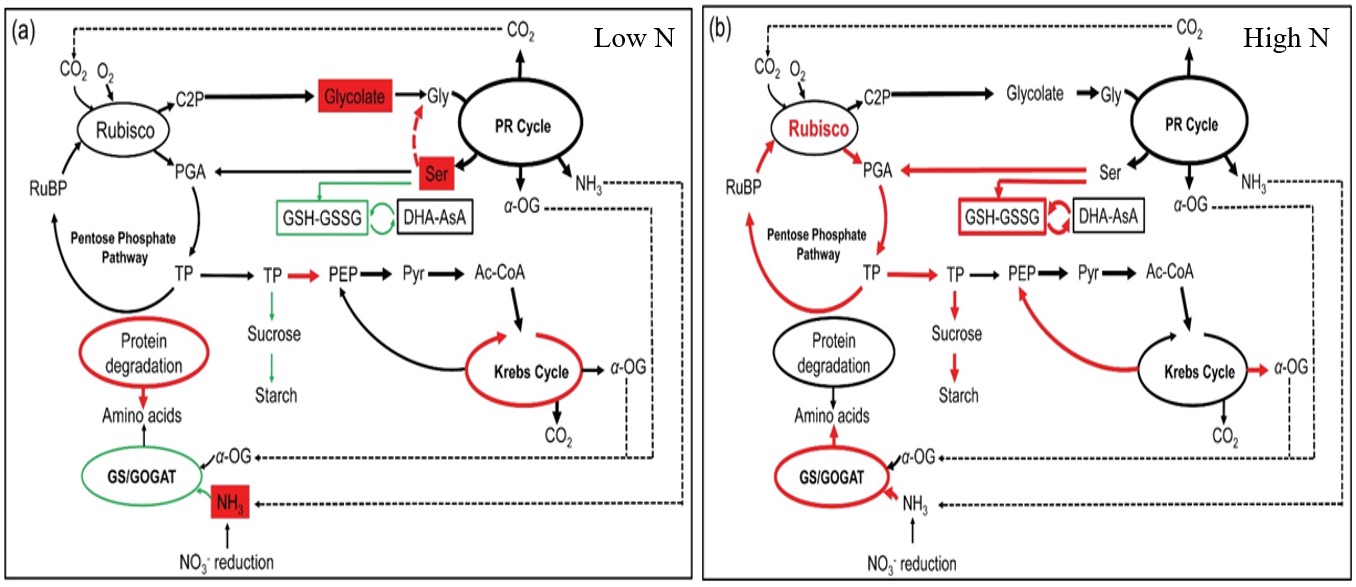Progress on the nitrogen metabolism and its adaptive mechanism of rice seedling under water stress
Recently, a series of papers reported by Jin Qianyu's research team from China National Rice Research Institute (CNRRI), Chinese Academy of Agricultural Sciences (CAAS) were published on the Environmental and Experimental Botany, Physiologia Plantarum, Plant Physiology and Biochemistry, and Plant Growth Regulation. The role of nitrogen metabolism and its adaptive mechanism under water deficit conditions from the points of leaf photosynthesis and nitrogen utilization were investigated in these papers.
Optimal allocation of nitrogen (N) in rice plays an important role in improving rice photosynthetic N-use efficiency and enhancing rice adaptability to water stress. The researchers focused on the drought-induced variations of N forms and N levels at root rhizosphere, and demonstrated the following findings: (1) The mixed-N-supplied (nitrate plus ammonium) rice was closely associated with higher accumulation of dry matter mainly via improvement of mesophyll conductance (gm) and photochemical efficiency (Vcmax, ФPSII), hormone balance (IAA,CTKs), and coupling with root-shoot carbon partitioning; two ammonium transporter genes (AMT1;2 and AMT1;3) closely related to NH4+ uptake and its subsequent N metabolism were also up-regulated in response to water stress. (2) At the high N level, plants decreased N allocation in bioenergetics or carboxylation, but increased N allocation in non-photosynthetic tissues during water stress. Meanwhile, plants grown showed an increased photorespiratory serine metabolism and glycerate recycling under water stress, which correlated with the enhancement of glutathione concentration and ascorbate-glutathione cycle, indicating that the serine metabolism plays a significant role in improving antioxidant capacity; additionally, aspartate aminotransferase (AspAT)- and serine:glyoxylate aminotransferase (SGAT)-mediated glutamate transamination and phosphoenolpyruvate carboxylase (PEPC)-mediated anaplerotic reaction provided a carbon skeleton, 2-oxoglutarate, for NH3 assimilation. The two factors play an important role in maintaining rice nutritional growth and adaptive capacity under the water stress condition. The results provide new insights for improving plant N use efficiency and tolerance to water stress via N resource management in certain drought-prone regions.
This study was supported by Agricultural Science and Technology Innovation Program (ASTIP) of CAAS (Grant No: CAAS-ASTIP-2013-CNRRI), National Key Research and Development Program of China (Nos. 2017YFD0300100), and Natural Science Foundation of Zhejiang Province (Grant No: LY18C130005, LQ15C130004). More details are available on the link below:
1. https://www.sciencedirect.com/science/article/pii/S0098847218309675
2. https://www.sciencedirect.com/science/article/pii/S0981942818305205
3. https://onlinelibrary.wiley.com/doi/abs/10.1111/ppl.12909
4. https://www.sciencedirect.com/science/article/pii/S098194281830398X
5. https://link.springer.com/article/10.1007/s10725-017-0352-6
6. https://www.sciencedirect.com/science/article/pii/S0981942818300305

-
 Apr 18, 2024Opening Ceremony of the Training Workshop on Wheat Head Scab Resistance Breeding and Pest Control in Africa Held in CAAS
Apr 18, 2024Opening Ceremony of the Training Workshop on Wheat Head Scab Resistance Breeding and Pest Control in Africa Held in CAAS -
 Apr 03, 2024IPPCAAS Co-organized the Training Workshop on Management and Application of Biopesticides in Nepal
Apr 03, 2024IPPCAAS Co-organized the Training Workshop on Management and Application of Biopesticides in Nepal -
 Mar 28, 2024Delegation from the School of Agriculture and Food Science of University College Dublin, Ireland Visit to IAS, CAAS
Mar 28, 2024Delegation from the School of Agriculture and Food Science of University College Dublin, Ireland Visit to IAS, CAAS -
 Mar 25, 2024Director of World Food Prize Foundation visited GSCAAS
Mar 25, 2024Director of World Food Prize Foundation visited GSCAAS -
 Mar 20, 2024Institute of Crop Sciences (ICS) and Syngenta Group Global Seeds Advance Collaborative Research in the Seed Industry
Mar 20, 2024Institute of Crop Sciences (ICS) and Syngenta Group Global Seeds Advance Collaborative Research in the Seed Industry
